Dehydrating jalapeño peppers is a great way to preserve the fresh pods. Jalapeños are the most common spicy pepper in North America. They are known for having thick walls like bell peppers while having moderate heat levels that most can enjoy.
They are also easy to grow at home, either in containers or in the ground. When you grow your own jalapeños, you end up with a lot of peppers. That is where dehydrating jalapeños comes in handy.
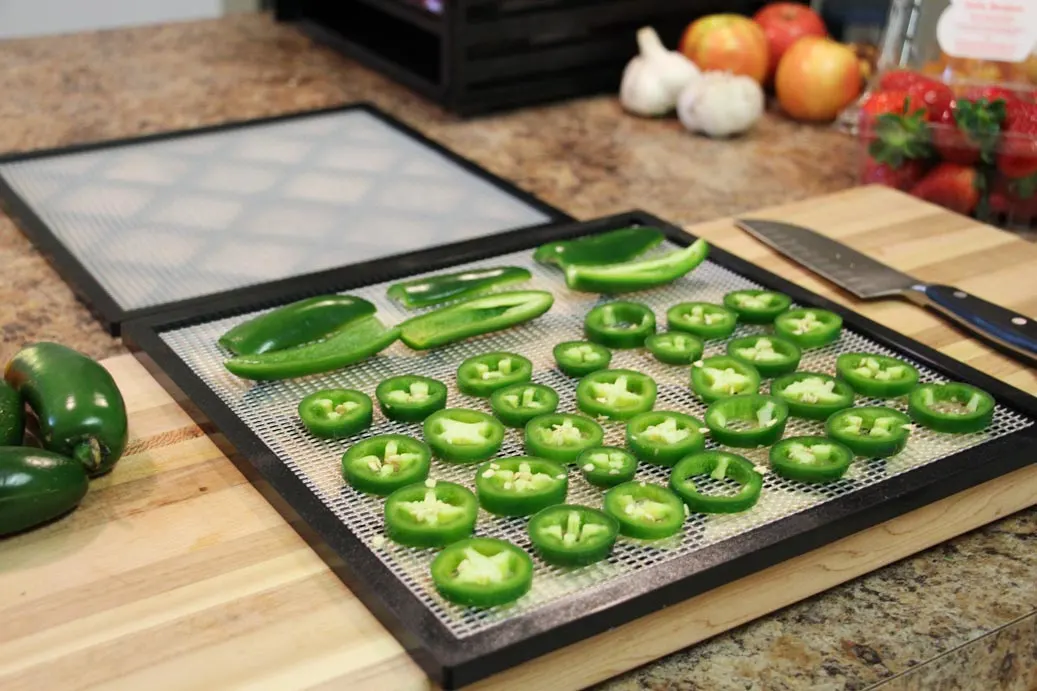
Dehydrating jalapeño peppers (or any pepper for that matter) involves removing the moisture from the pepper. There are many ways to accomplish this, from simply leaving the peppers out in a well-ventilated room, to using a purpose-built dehydrator.
We want to help you get the perfect results with your dehydrated jalapeños, regardless of how you do it! The benefits are many: Long term storage, reduced storage size, and delicious flavor.
Jump Ahead:
- How-to: With a dehydrator
- How-to: Without a dehydrator
- Storing dried jalapeños
- Making jalapeno powder
- Rehydrating peppers
- Other ways to preserve
Can You Dry Jalapeño Peppers?
Yes, jalapeños can be dried in a number of ways. Since they are thicker than other hot peppers, they may take longer, especially if dried whole.
However, jalapeños and other pepper varieties like habaneros have been dehydrated for thousands of years. This means that using a dedicated food dehydrator is not your only option! There are essentially three basic methods:
- Use a dehydrator. If you have a food dehydrator, then we recommend you use it. We use an Excalibur food dehydrator for its ease of use and the ability to set a relatively low temperature. These are known for circulating air well and keeping a consistent temperature. This helps keep your jalapeños nice and green (high heat can cause discoloration).
- Use the oven. Not everyone has the need or space for a designated food dehydrator. However, most people do have an oven. While this method is not always ideal, it will get the job done. There are some drawbacks to dehydrating your peppers in the oven. Most ovens have a minimum temperature setting above the recommended level for dehydrating. This can cause unwanted cooking of your fresh jalapenos. Using the oven is not the most cost-effective and can heat up your home when running for several hours. Some toaster ovens have a dehydrate setting as well.
- Air dry. This won’t work for everyone. If you live in an arid climate, then this option will suit you just fine. However, if the air is above 50-60% humidity, your jalapeños will have trouble fully drying out and may grow mold before completely drying.
How To Dehydrate Jalapeño Peppers
We are going to start with the ideal method for dehydrating jalapeños: Using a food dehydrator. We use the Excalibur 2400 (the smallest and least expensive Excalibur). However, any food dehydrator should do the trick.

Excalibur 2400 – see on Amazon
It works very well and has plenty of space for our needs. However, all dehydrators work similarly. If you have a dehydrator, here is how to dry out your jalapeno peppers.
How to dry jalapeños in a dehydrator (steps):
- Sort and select peppers.
If you have a lot of jalapeños to dry, you should choose the highest quality peppers. Look for any with rot, holes, or mold and discard them.
- Wash and dry the peppers.
Clean the jalapeños with cool water. Be sure to thoroughly dry the peppers before slicing. You don’t want your dehydrator to waste time drying out droplets of water.
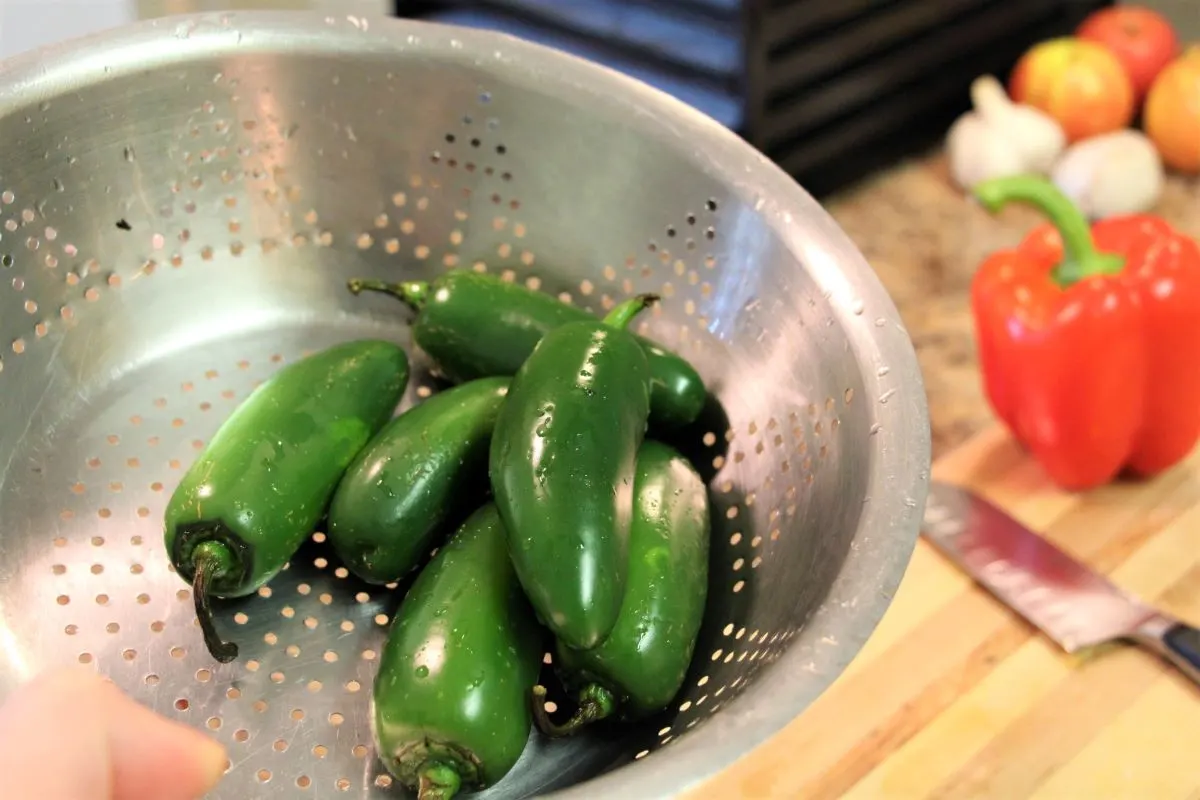
- Slice the peppers.
Remove the stems and slice the peppers in the desired shape. We prefer 1/4 inch jalapeño saucers. They are great for snacking and for adding to sandwiches. Thin slices will dry much faster than thicker cuts. If drying whole jalapeños, slice a few slits in the skin to allow air to reach within the peppers.
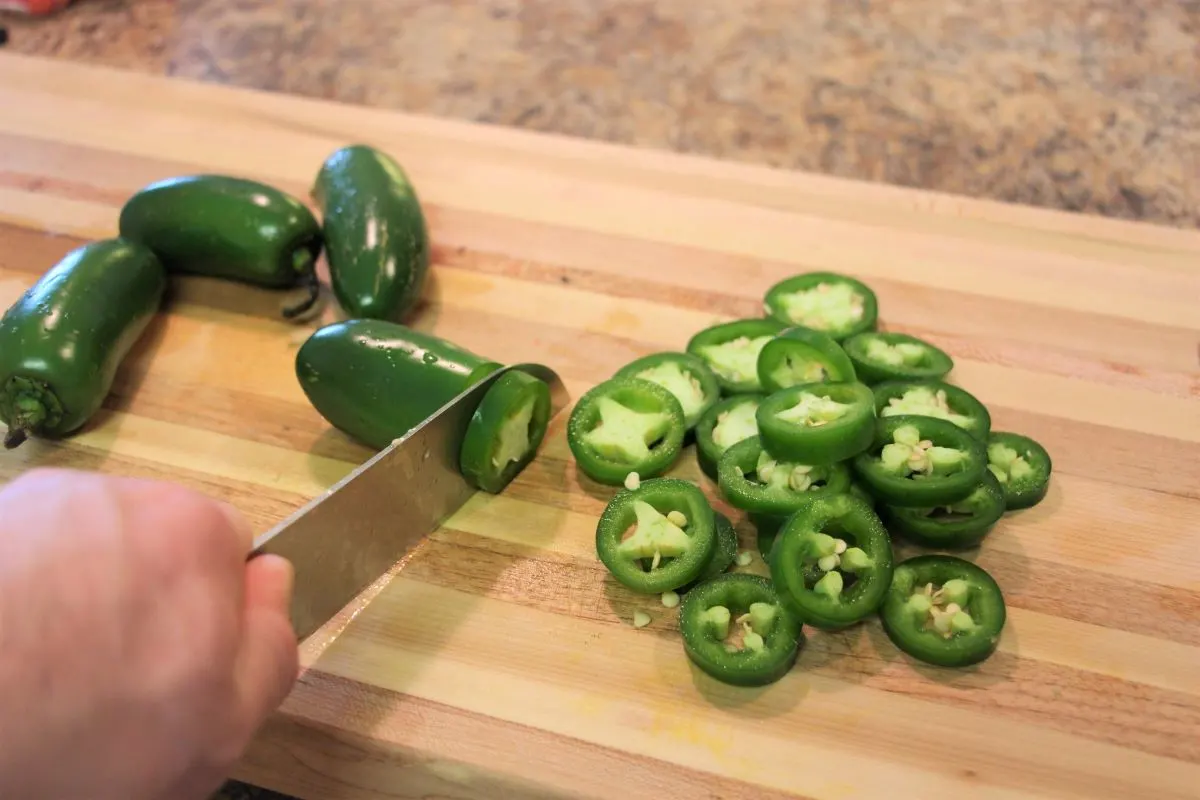
- Arrange on dehydrator trays.
Arrange your jalapeño slices evenly across your dehydrator trays. Give some room between peppers and try not to overlap the slices. This will promote more even drying of all the chilies.
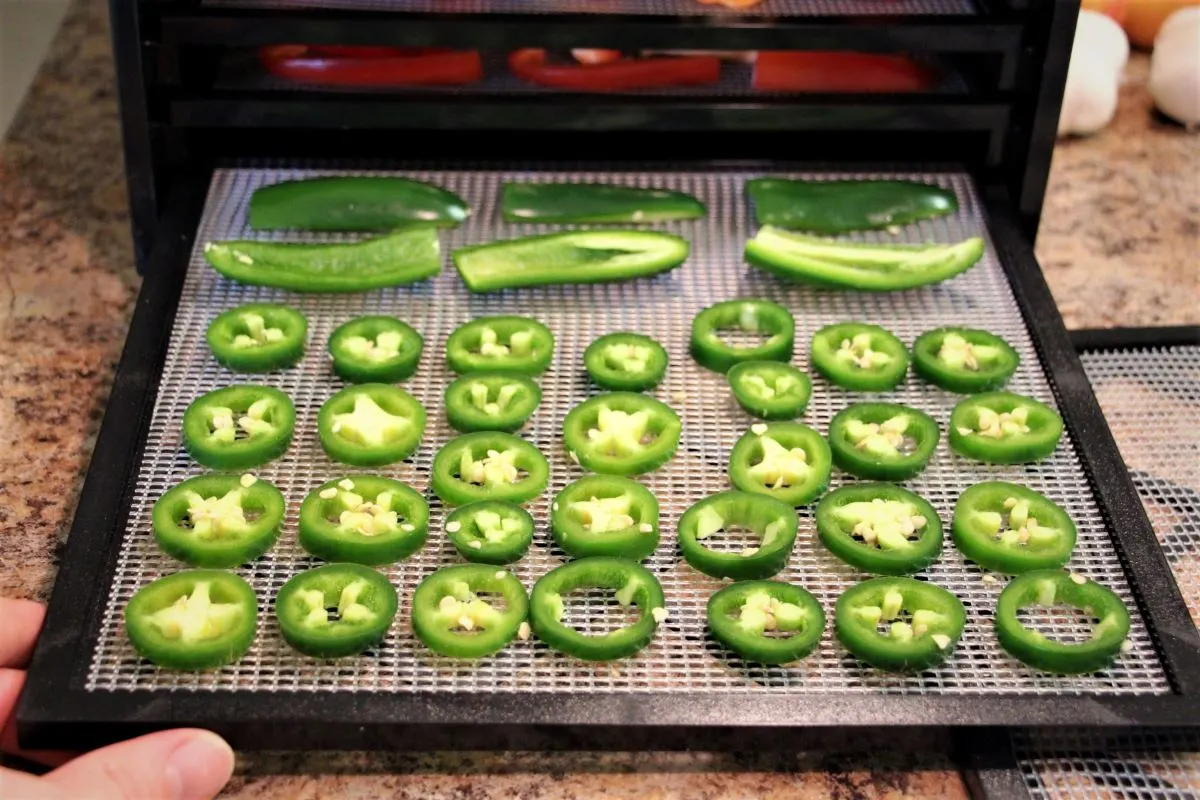
- Set temperature to 125°F (52°C).
The ideal temperature to dry peppers is right around 125°F. This is enough heat to help speed up drying without cooking the peppers.
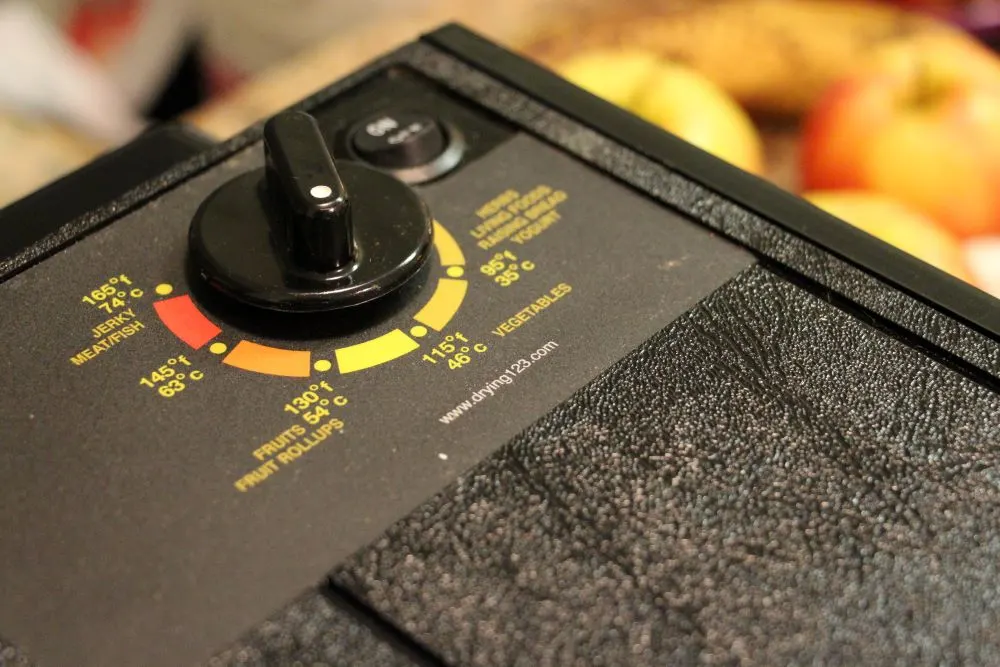
- Dehydrate for 6-10 hours (or longer).
Depending on the thickness of your slices, dehydrating times will vary greatly. You can also stop dehydrating at different stages based on preference.
We prefer to stop drying when jalapeño peppers have reached a leathery texture (not brittle). However, if you are planning to grind the peppers into a powder, you should dehydrate until they are brittle and stiff.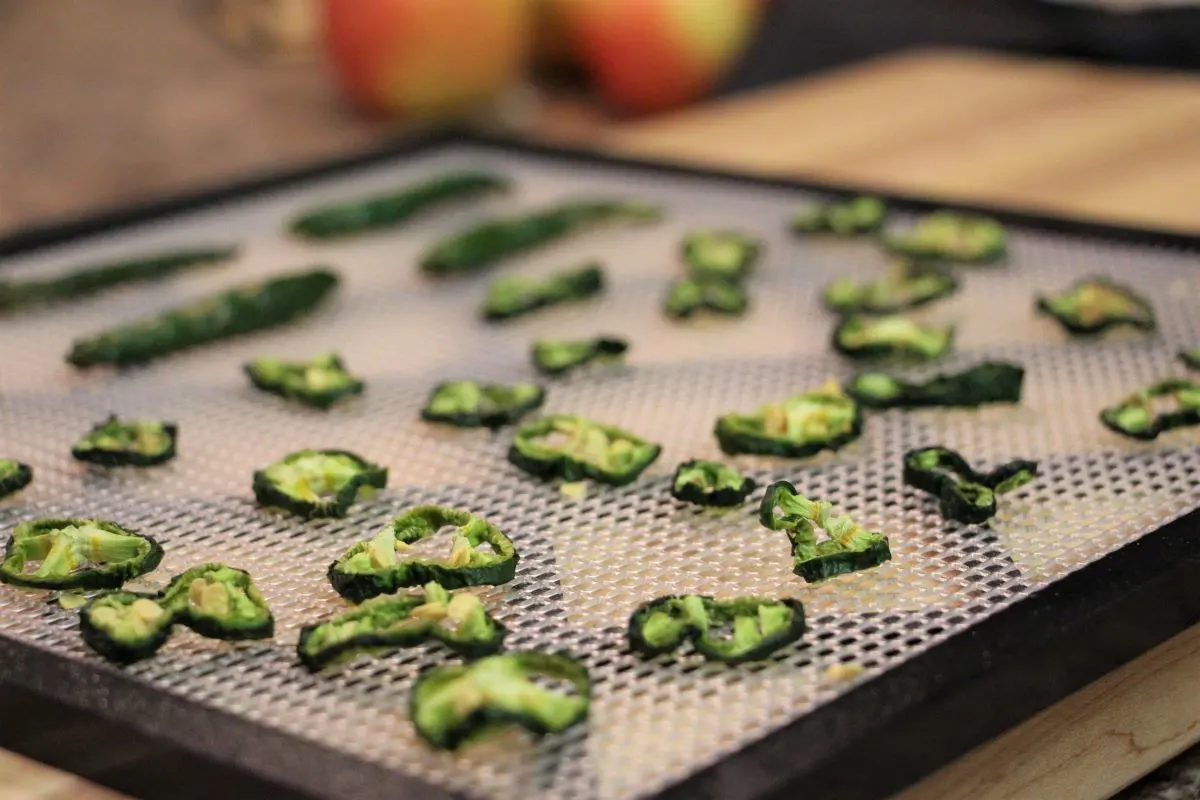
- Store peppers in a dry, sealed container.
Use freezer bags or mason jars with a desiccant packet to keep peppers dry. Dehydrated jalapenos can be kept for up to a year when stored properly.
Following these steps will bring your jalapeño peppers to the perfect consistency. Remember to check your peppers every few hours to ensure they don’t go beyond your desired dryness.
Tip: Start drying jalapeños in the morning to avoid leaving your dehydrator on overnight.
How long to dry jalapeños in a dehydrator
How long you dehydrate jalapeños will depend on your goal. Most dehydrator instructions will recommend to dehydrate peppers for 6-10 hours until they reach a leathery consistency. This is ideal for snacking and for rehydrating peppers later. If you wish to grind peppers to a powder, dehydrate until they crack when squeezed.
Times will vary from 6-12 hours or longer depending on the size and thickness of the peppers and your desired dryness.
Check on your dehydrator every few hours to see where the peppers are at in the process. Don’t check more often than every 2 hours to avoid releasing heat and dry air from the dehydrator.
Dehydrating Jalapeño Peppers In The Oven
If you haven’t yet made the leap on buying a dedicated food dehydrator, the oven is the next best thing. The process is similar, but it may take longer depending on the type of oven you have.
One of the benefits of a food dehydrator is its ability to circulate air. This dries out fruit and vegetables much faster than stagnant air in a standard oven. For this reason, convection ovens are best for dehydrating.
Check out the Ninja Foodi toaster oven – it doubles as a food dehydrator with circulating air.
Here are the basic steps for dehydrating jalapeños in the oven:
- Wash & dry the peppers. As always, make sure your peppers are cleaned and dried before slicing.
- Slice peppers. Cut off the stems and slice the peppers into the desired shape. Remember to be consistent in size and shape for even drying. Remove seeds and placenta at this stage if desired.
- Arrange peppers on an oven-safe drying rack. In order to allow the peppers to receive as much dry air as possible, place them on a drying rack on a cookie sheet. This will speed up the drying process.
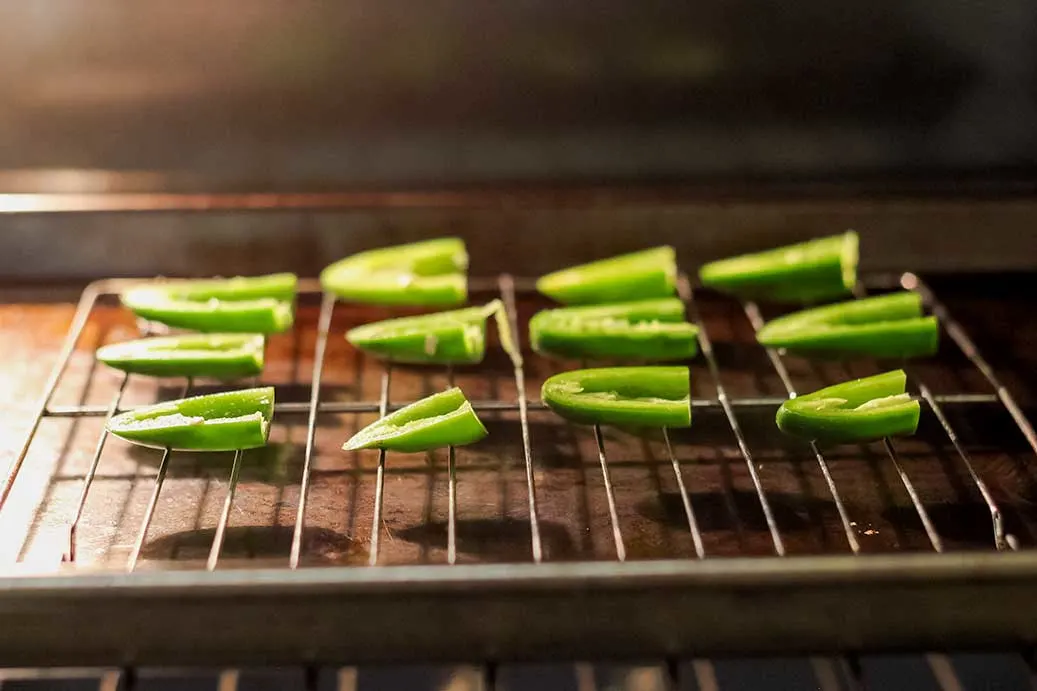
- Preheat oven to the lowest temperature. Many ovens have a low temperature of around 150°F. Set your oven to its lowest temperature, or ideally 125°F.
- Bake for 6-12 hours or until the peppers are dried. Check on the peppers after about 4 hours if you have a convection oven. You may want the peppers to be fully dried or slightly leathery depending on your intended use.
Remember that the thicker your slices, the longer the process will take. It will also take much longer in a standard oven than in a convection oven with air circulation.
If you do a lot of dehydrating, consider getting a dedicated dehydrator! It is a lot of fun experimenting with dehydrating various foods (and making jerky).
How To Air Dry Jalapeño Peppers
If you want to go old school, you can try dehydrating your jalapenos by hanging them to air-dry. This is the most ancient method for drying fresh produce. The main drawback? It takes much longer.
Also, if the humidity in the air is above 50-60%, you may have trouble reaching truly dried out peppers. Use one of the other methods above for better results.
Using A Fan
Have a fan? That will help! If you don’t have a drafty room where you can hang-dry peppers, a fan can mimic a breeze. Set up your peppers on a plate or arranged on a drying rack and aim your fan directly at the peppers.
Allow them to dry, rotating occasionally, for 1-2 weeks. It may take longer if you live in a more humid environment. Peppers are adequately dried when they reach a leathery consistency and are significantly lighter in weight.
Jalapeños will likely not dry to a brittle texture by fan only. Use the oven method for a few more hours to reach a grindable dryness.
How To String Jalapeño Peppers For Drying
Another option is to hang-dry your jalapeños. This is a good option if you have a covered outdoor area or a room that gets lots of airflow. Stringing peppers into a ristra is easy.
What you’ll need:
- Strong string or fishing line (not too thick)
- Needle
- Peppers
Tip: Since jalapeños are thick-walled, they will take much longer to air-dry. Be sure to use only the healthiest peppers to avoid mold or rot setting in.
Start by tying the string or line to your needle. Poke the needle through the first pepper at the base of its stem, threading the string through by about 2 feet (60cm). Tie a strong knot around the first pepper’s stem.
Continue piercing additional peppers through their stems until you have a bouquet of peppers on your string. Be sure not to add more peppers than the string can support without breaking.
Hang the strung peppers in a drafty room or outdoors where they will receive plenty of airflow. Depending on the air moisture level, your peppers should be dried within 2-4 weeks or longer. Help speed up the process by giving the jalapenos a shake once or twice a day.
How Long Do Dried Jalapeños Last?
If you are drying for long-term preservation, you’ll be happy to know that dried jalapeños will keep for 1 year or longer when stored properly.
Follow these guidelines to avoid the possibility of spoiling:
- Store them in sealed containers with minimal air
- Use mason jars with food-safe desiccant packets
- Store out of sunlight
- Keep cool
Following these tips will help ensure safe consumption for many months, but always be diligent and check peppers for any signs of mold before consuming. If you’re unsure, always better to be safe and throw them out.
Tip: Store dried peppers in multiple containers so that if one becomes moldy, not all are lost.
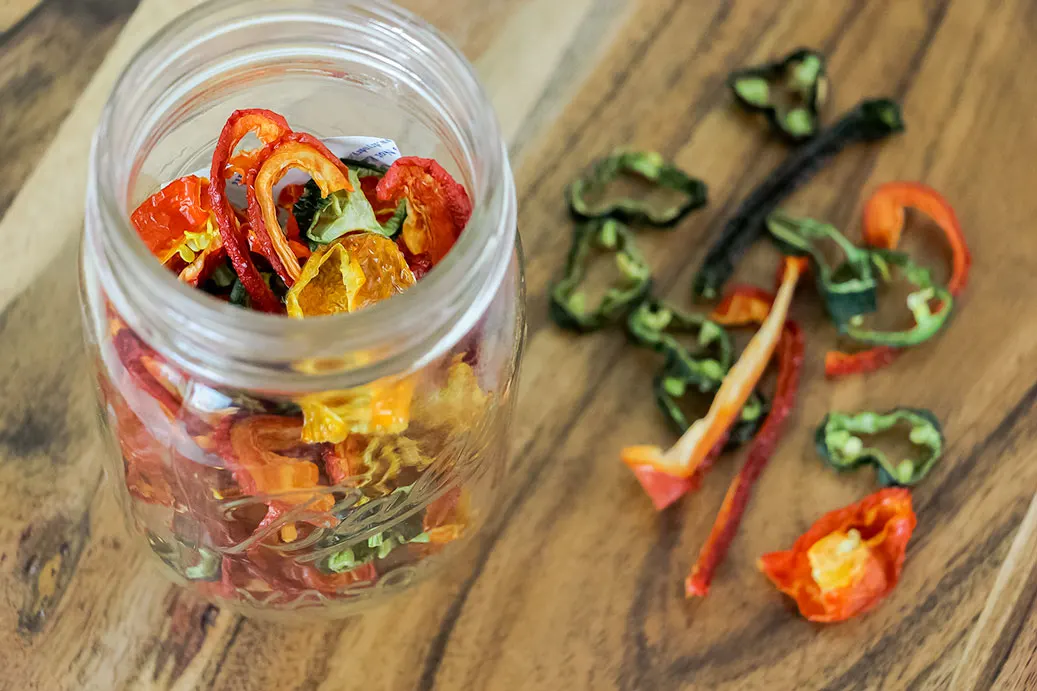
How To Make Jalapeño Pepper Powder
Making jalapeño powder is a great way to use your dehydrated peppers. It’s a spicy alternative to cayenne pepper powder that gives food a unique and tangy flavor.
Read our complete guide to making powdered jalapeño here.
Quick steps for making jalapeño powder:
- Dehydrate peppers until brittle. The peppers should easily crack when squeezed.
- Pulse in grinder or blender. A spice or coffee grinder is ideal, but a strong blender will work as well. Make sure the grinder is completely dry before adding your dried jalapeños.
- Store in a spice container. As long as it is kept dry and cool, jalapeño powder should last a year or longer.
- Remove seeds before dehydrating (optional). If you don’t have a spice grinder, grinding seeds can be difficult. You can also save your seeds for growing next year.
Use your jalapeño powder for spicing up soup, adding to eggs, making aioli and more!
Tip: Try smoking your jalapenos before grinding them into a powder. Learn how to make chipotle powder here.
Rehydrating Dried Jalapeño Peppers
To reconstitute your dried jalapeños, submerge them in hot water for 10-15 minutes. If they float, keep them under the water with plate or a bowl. The peppers should come back to nearly their original shape and size.
See more ways to use dried peppers here.
Rehydrated jalapeños will not have the same crispness or texture as fresh peppers. However, flavor and heat levels should be nearly identical to the original peppers.
Other Methods to Preserve Jalapeño
While dehydrating is a great way to preserve your jalapeño harvests, there are many other ways to use them while they are fresh. Here are a few of our favorite jalapeños storage methods with guides on how to do them yourself.
- Pickling – Delicious and crunchy pickled jalapeños.
- Freezing – Retain as much of the original flavor and heat of the peppers.
- Making hot sauce – Get creative with other spices and flavors in a homemade sauce.
I hope this article helped you learn how to dry jalapeños at home. If you have any suggestions or ideas, feel free to reach out.


Jun
Sunday 8th of January 2023
Hi Calvin, and thanks for this. I make my own chilli oils and usually just dry the (whole) chillies on a shelf in the garage for a few days. Usually no problem. Recently I started chopping them up (to dry quicker) but now most of them start turning red (which I'd prefer not to happen). Any suggestions? Thanks again
peppergeek
Monday 9th of January 2023
Hi Jun - it sounds like the fruits may have been harvested later than usual, leading the peppers to ripen off the plant. If they are harvested earlier, they should stay green, cut or not.
Jim
Monday 7th of November 2022
Awesome! Thank you. I've been wonder how dry. I can't use all the pepper pickles & sauces I have so drying is another great alternative, with maybe more options for later uses.
Greddle
Sunday 25th of September 2022
Can You dehydrate peppers in a toaster
peppergeek
Tuesday 27th of September 2022
Some newer toaster ovens have a low-heat/dehydrate feature, yes. But since it takes a LONG time to dehydrate in an oven, I would probably not feel safe doing it in the toaster oven
Carol
Sunday 28th of August 2022
I don't yet have a dedicated dehydrator, so for the time being I'm using my air fryer toaster oven, which has a "dehydrate" setting. Using that setting, I get temperature increments of 10° rather than 5°. Since I can't set it to 125°, am I better off with 120° rather than 130°? I realize it will take a little longer; I'm just wondering if 120° will be enough.
dave
Monday 17th of October 2022
@Carol, typical air fryer aka toaster ovens have fairly inaccurate thermostats and both hot and cold areas in them unless they have a fairly strong fan which most do not.
You could measure the temperature to see how accurate it is, but I'd be inclined to set it to the lower temperature but the most important thing is the evacuation of the moisture. If you merely cook them at a low temperature and they are creating a steam bath, it will take forever and the result will be poor. At the same time, a mere 10 degree temperature difference is not much, will not make a significant difference in time taken or the result.
Airflow to remove the moisture is the most important part, not temperature, but the heat accelerates that so that they don't rot before dehydrated enough. Choose more airflow before more temperature, unless it is very humid where you are doing this.
Jack
Thursday 26th of May 2022
When using oven may leave door open a crack wooden spoon works